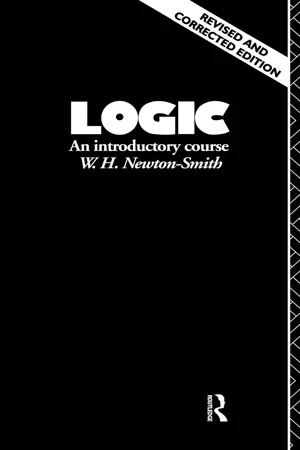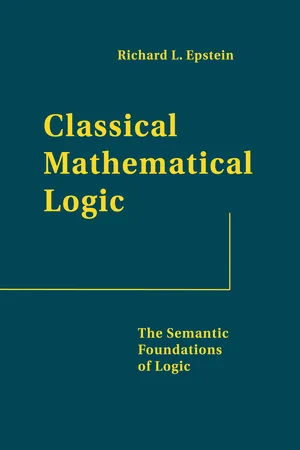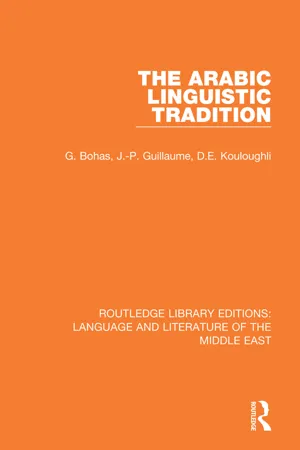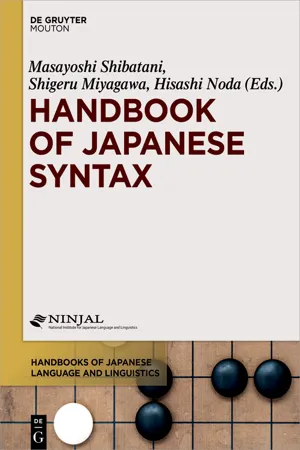Languages & Linguistics
Predicates
In linguistics, predicates are the part of a sentence that provides information about the subject. They typically include a verb and any accompanying objects, complements, or modifiers. Predicates are essential for conveying the action or state of the subject and are a fundamental component of sentence structure.
Written by Perlego with AI-assistance
4 Key excerpts on "Predicates"
- eBook - ePub
Logic
An Introductory Course
- W.H. Newton-Smith(Author)
- 2003(Publication Date)
- Routledge(Publisher)
CHAPTER 8 Predicate logic semantics 1 THE PREDICATE LANGUAGE Logic is the study of valid arguments. In the early chapters of this work we developed a propositional language and provided a definition of validity for arguments expressible in that language. We saw that there were valid arguments not expressible in the propositional language. Hence we enriched it to obtain a predicate language. We have yet to develop a definition of validity appropriate to this enriched language. This is a considerably more complex business than was the case for the propositional language. A valid argument is one which is such that if the premises are true the conclusion must be true. Thus a detailed definition of validity for the arguments expressible in a given language depends on a definition of truth for the sentences of that language. In the case of a propositional language it is relatively simple to explicate the notion of truth of an arbitrary sentence of that language by reference to the notion of the truth of a simple sentence taken together with the notion of a truth-table. That is, we arrive at the truth-value of a complex sentence from an assignment of truth-values to the simple sentences which are parts of the sentence with the aid of truth-tables. However, in the case of the predicate language, the parts of our complex sentences are not necessarily sentences. To see this compare the propositional language sentence ‘ P → Q ’ with the predicate language sentence ‘(∀ x)(Fx → Gx)’. In the former case some parts, i.e. ‘ P’, ‘Q’ are themselves sentences. In the latter case neither ‘(∀ x)’, ‘ Fx’, nor ‘ Gx’ are sentences. The complexities that this produces will take us some time to explore and in this introductory work we will not be able to do more than indicate the direction to be followed in developing a rigorous definition of truth - eBook - ePub
Classical Mathematical Logic
The Semantic Foundations of Logic
- Richard L. Epstein(Author)
- 2011(Publication Date)
- Princeton University Press(Publisher)
We have two choices. We may say that when we took ‘—loves—’ to be a predicate we weren't thinking of names of all things as being suitable to fill in the blanks, but only, say, names of people and animals. That is, we can restrict what kinds of things we are talking about.Alternatively, we can assume there is a homogeneity to all things: Whatever can be asserted about one thing can be asserted about any other, though of course the assertion may be false. In that case, ‘7 loves Juney’ wouldn't be nonsensical, but false. In either case, what Predicates we reason with depends in part on what things we are talking about.In order to reduce ambiguity, let's require that each name-place of a predicate has a separate dash associated with it, and that for any particular predicate the number of dashes won't vary. We don't want ‘—is the brother of—’ to be a predicate if by that we mean the latter blank can be filled with as many names as we wish. The number of blanks in a predicate is its arity : if a predicate has one blank it is unary, if two it is binary, if three it is ternary,…. Predicates other than unary ones are often called relations.When it is clear where and how many dashes occur in a predicate we may informally leave the dashes off, saying ‘barks’ or ‘is green’ or ‘is the father of’ are Predicates. Some writers leave the word ‘is’ to be understood too, saying, for example, that ‘green’ is a predicate.This definition of ‘predicate’ recognizes two primitive grammatical categories: propositions and names. What other grammatical categories shall we recognize?C. Propositional ConnectivesWe take propositions as fundamental, and so we continue to recognize the ways of forming new propositions from others as in propositional logic. As before, we'll concentrate on formalizations of ‘and’, ‘or’, ‘if…then…’, and ‘not’, symbolized byAn atomic proposition in propositional logic was one whose internal structure was not taken into account. Thus ‘Ralph sits’ was atomic. But now we recognize the structure of that proposition as made up of a name and a predicate. Nonetheless, let us continue to classify it as atomic - eBook - ePub
- Georges Bohas, Jean-Patrick Guillaume, Djamel Eddine Kouloughli(Authors)
- 2016(Publication Date)
- Routledge(Publisher)
In this text, the speaker, referred to as the ‘informer’ or ‘asserter’, is considered as the source of the predicative relationship and as assuming the responsibility of the truth value of the assertion so produced. This way of considering predication as resting on the activity of the speaker is, of course, consonant with what has previously been said about the classification of utterances by the strength of their assertion. The predication is affirmative or negative, strong or neutral according to the speaker’s beliefs and to what he or she anticipates of the addressee’s attitudes to what he or she wants to tell the addressee.As to the concept of ‘constraints’, it appears as a remarkably unifying instrument of analysis of all the possible operations of determination and specification which contribute to making language fit the communicative needs of its users. For rhetoricians, everything that allows the speaker to make his or her meaning more specific is a ‘constraint’, whether it be the determiners which restrain the extension of nouns, the complements which define the spatial and temporal location of the event associated with the verb or its terminus ad quem, or the different ways of describing entities or actions. Even the corroborative markers whose status has been discussed earlier are considered as constraints applying not to the predicand or predicate but to predication itself, as they allow the speaker to modulate the strength of his assertion.Of course, ‘constraining’ (taqyīd) is considered a recursive operation: a qayd such as the direct object of a verb may very well be specified by an adjective, which would then be analysed as a qayd in the first qayd. In the same trend, nothing prevents a qayd from having itself the structure of a predicative relationship: you may very well wish to specify a noun with a whole sentence, as is the case with relatives. But in such a case this predicative relationship is somehow incomplete, because it lacks the predication element: this is because, however complex an utterance may be, recognizing it as a single utterance necessarily means that it has a single meaning and hence results from a single act of predication. When analysing complex utterances, some rhetoricians sometimes qualify the ‘main’ predicative structure, the one endowed with predication, as being ‘the main sentence’ (al-ǧumla al-raʼīsiyya) and speak of ‘secondary sentences’ (ǧumal ḡayr raʼīsiyya) when dealing with those predicative structures which function as ‘constraints’ in an utterance. But all consistently reserve the term ‘utterance’ (kalām - eBook - ePub
- Masayoshi Shibatani, Shigeru Miyagawa, Hisashi Noda(Authors)
- 2017(Publication Date)
- De Gruyter Mouton(Publisher)
In a predicate sentence, the predicate word is the controlling constituent and forms the core of the sentence. The sentence is formed by the predicate taking forms to complete it. The structure of and the governing power and centrality of the predicate part of a predicate sentence differ greatly among verbal, adjectival, and nominal sentences.3.1Basic structure of a verbal sentence
Let us start with a very brief overview of the basic structure of verbal sentences. The verb forms the predicate and influences the structure of the sentence. Depending on the lexical type of the verb, the kinds of elements that can co-occur with the predicate verb are different.3.1.1The nucleus of the sentence structure
Let us first consider the most nuclear part of the structure of a verbal sentence.In a sentence like (8) with the verb kareru ‘wither’ as the predicate, only a subordinate element marked with the nominative ga is necessary for the action expressed by the predicate to be realized. Incidentally, let us here broadly divide sentences by their meaning into action, stative, and attributive. The minimum necessary elements for the action expressed by the verb that is the predicate in example sentences (9) through (13) are as described below. In sentence (9) with nagusameru ‘console’ as the predicate, a nominative ga -marked element and an accusative o -marked element are necessary, and in (10) with kamituku ‘bite’ as predicate, a ga -marked element and a dative ni -marked element are necessary. In (11) with kekkonsuru ‘get married’ as predicate a ga- marked element and a comitative to -marked element are needed, and in (12) with okuru ‘send’ as predicate, a ga -marked, an o -marked, and a ni -marked element are necessary. In (13) with atumeru ‘collect’ as predicate, a ga -marked, an o -marked and an ablative kara -marked element are necessary.As seen above, for a verb functioning as predicate to realize the action its lexical meaning expresses requires that the predicate co-occur with noun phrases or noun-like elements having a lexically determined case relationship. In Nitta (2010), the noun-like elements that are required to co-occur with the predicate verb are termed case elements or co-occurring elements (actants). In other words, when a verb becomes a predicate and forms a sentence, in order to realize the action it expresses, it acts to selectively require a set of actants that participate in the realization of that action. [N-ga ], [N-ga , N-o ], [N-ga , N-ni ], [N-ga , N-to ], [N-ga , N-o , N-ni ], [N-ga , N-o , N-kara
Index pages curate the most relevant extracts from our library of academic textbooks. They’ve been created using an in-house natural language model (NLM), each adding context and meaning to key research topics.
Explore more topic indexes
Explore more topic indexes
1 of 6
Explore more topic indexes
1 of 4



